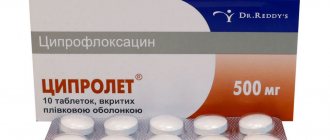The combined drug Novigan quickly eliminates the painful symptoms of algomenorrhea, colic in the stomach and abdominal cavity, and can be used for fever and migraines. The formula of the drug provides improved well-being with cramps, elevated body temperature, and headaches of various origins.
Composition, dosage form
Novigan is available in the form of tablets for oral use: film-coated, packaged in metallized blisters. Each pill contains:
- ibuprofen: 0.4 g;
- fenpiverinium bromide: 0.005 g;
- pitofenone: 0.1 g.
Auxiliary compounds that stabilize the state of the drug and give it shape:
- glycerol;
- talc;
- starch;
- magnesium stearate;
- polysorbate and others.
The secondary cardboard packaging of the medicine contains from 2 to 10 blisters with tablets and detailed instructions included.
The mechanism of action of the drug Novigan
Novigan tablets effectively relieve various types of pain and physical discomfort. The drug is used as an analgesic, antispasmodic and anti-inflammatory. Ibuprofen in its composition provides a blockade of prostaglandins, including those in the peripheral nervous system and tissues of internal organs. At the same time, the substance affects the thermoregulation center, reducing fever and associated discomfort.
Pitophenone hydrochloride is a myotropic antispasmodic that relaxes smooth muscle fibers. Its use helps relieve painful contractions of vascular walls and cavitary organs. Fenpiverinium bromide complements and prolongs its action, having an anticholinergic effect.
The tablet shell quickly dissolves in the stomach cavity, the active substances are absorbed into the blood and distributed in the body fluids, partially binding to plasma proteins. The maximum concentration is usually achieved within 1 hour, and the pharmacological effect develops within 15–20 minutes after administration. The drug is transformed by liver cells, metabolites leave the body along with urine. Residues of the drug remain in tissues and blood for no more than 12 hours.
Novigan has a symptomatic effect, reducing the painful manifestations of pathological conditions. It does not affect the course and causes of chronic diseases.
How to treat during pregnancy
During pregnancy, it is allowed to have teeth filled and even have them removed. Dental fillings during pregnancy are carried out according to the standard procedure. Modern materials from which fillings are made do not cause any harm to either the mother or the child.
Painful procedures, including tooth extraction, are performed under local anesthesia. The anesthetic drug is chosen very carefully. The dentist must be familiar with the timing of pregnancy and contraindications in order to select the drug that is most suitable for a particular patient.
X-rays should be taken very carefully during pregnancy. If you cannot do without it during dental treatment, then it is best to take the photo in a modern dental clinic with equipment that meets high international standards. To further protect the woman and fetus from X-rays, the chest, pelvis and abdominal area are covered with a special fabric during the X-ray.
Dentists say that it is best to treat teeth during pregnancy in the second trimester. This is a period of relative calm between the critical points of pregnancy in the first trimester (when the fetus is just beginning to develop) and in the third trimester (when the fetus is almost fully formed).
Indications for use
It is recommended to take Novigan for any pain syndrome, including those accompanied by spasms or colic:
- for painful menstruation: active components significantly reduce the production of prostaglandins in the female myometrium, relieve pressure in the vessels of the uterus and appendages, help get rid of cramping attacks before the start of the cycle and throughout menstruation;
- with inflammatory processes in the pelvic and abdominal organs: adnexitis, renal colic, pain in the liver, intestines, gall bladder;
- with cystitis;
- for tension headaches caused by poor circulation due to cervical osteochondrosis, for migraines, and meteosensitivity;
- with myositis;
- with neuralgic syndrome;
- for inflammation and degenerative processes in the joints and spine: arthritis, osteoarthrosis, sciatica, lumbodynia;
- for mechanical injuries of joint structures and muscles: bruises, pinching, dislocations, sprains and torn ligaments;
- during the recovery period after surgical interventions.
If necessary, Novigan can be used to relieve toothache. Ibuprofen in its composition reduces the sensitivity of nerves, reducing unpleasant symptoms.
15% of women suffer from endometriosis
Endometriosis occurs when cells from the endometrium (the lining of the uterus) extend beyond the uterine cavity, become attached and begin to grow in other organs. They go through the same monthly cycle as normal endometrial cells, but cannot leave the body as they do during menstruation. This causes inflammation and further formation of scar tissue in the affected areas. And where there is inflammation, there is pain! And, unfortunately, not only pain...
Fact #1
Endometriosis cannot be cured
This sounds harsh, I don’t want to believe it, but today it is true. However, there is good news: the disease can be “curbed”, as a result you can have a good quality of life and avoid infertility, premature menopause, etc.
This is why endometriosis requires long-term treatment, right up to menopause. Even if the disease is incurable, this does not mean that from now on it controls your life. Only a gynecologist can choose the right treatment and develop tactics for managing your condition with endometriosis.
Fact #2
Endometriosis is not easy suffering during menstruation
Endometriosis can significantly affect work ability and overall quality of life, creating problems during the childbearing period, one of which is infertility (more than half of women suffer from this), and can sometimes continue even after menopause.
Fact #3
Pain can occur at any time, not just during menstruation
Pain can occur during urination, defecation, sexual intercourse (depending on the location of the lesions), and sometimes for no apparent reason at all. Sometimes you can predict when your pain will be worse, but endometriosis is usually unpredictable.
Fact #4
Diagnosing endometriosis is not easy
The time from the onset of symptoms to diagnosis can take up to 8 years or more. Women turn to different specialists who make different diagnoses. And often, to relieve pain during menstruation, without a thorough questioning and examination of the patient, painkillers are prescribed, which can mask the symptoms for many years, while the disease progresses.
Fact #5
Endometriosis affects both the physical and mental state of a woman
Pain itself can be the reason for missing work or school, your refusal to engage in social activities, or your avoidance of sexual contacts. Irritability, anxiety, depression, even depression are quite common phenomena in patients with endometriosis.
Fact #6
Endometriosis can affect every woman differently
Even if you find two women with endometriosis in the same places, the likelihood that they will experience the same symptoms is relatively small. Almost all women will experience pain, but its nature and location may differ significantly. Stage I (mild) endometriosis may cause more pain than stage IV (extensive) endometriosis.
Fact No. 7
There is no one-size-fits-all treatment or even combination of treatments that will work for all patients
Treatment is always individualized. For treatment, surgical intervention is used, as well as drug treatment - hormonal drugs and drugs that affect the production of hormones (gonadotropin-releasing hormone agonists)
Fact #8
With endometriosis, the main hormones of femininity - estrogens, work against us
Estrogens normally promote endometrial growth at the beginning of each menstrual cycle. However, with endometriosis, estrogens cause the progression of the disease, because regardless of which organ the cells of the inner lining of the uterus “take root”, they also respond to estrogens, like normal tissue. Therefore, hormonal drugs for the treatment of endometriosis should not contain estrogens.
Fact #9
After childbirth, endometriosis is not cured and may even progress
There is a misconception that pregnancy and childbirth can, if not cure, then at least cause regression of the disease. Alas, this is not true. Endometriosis can progress after childbirth. However, childbirth saves you from something else - it is a powerful prevention of ovarian cancer, the risk of which increases with endometriosis.
Fact #10
You can't stand the pain
Patience and perseverance are inappropriate here. If pain is not stopped in time, it can become chronic: in this case, nerve cells are damaged and perceive pain more acutely. That is, pain sensitivity in general increases: you will feel any pain, even toothache and headache, more acutely than women who do not suffer from endometriosis.
Contraindications
The use of the drug is prohibited for the following health conditions:
- bronchial asthma;
- hypersensitivity to acetylsalicylic acid and other NSAIDs;
- for disorders of blood coagulation and composition, pathologies of the hematopoietic organs;
- for diseases and dystrophy of the optic nerve, glaucoma;
- gastric ulcer, acute colitis, pancreatitis, gastritis, erosive lesions of the gastrointestinal mucosa;
- with a tendency to internal bleeding;
- in the period after heart surgery, with acute cardiac arrhythmias.
Novigan is also not applicable in the early stages of pregnancy - in the first trimester, and in the last month before childbirth. It is contraindicated for nursing women and children under 14 years of age.
The drug is prescribed with caution to the elderly, patients with diabetes mellitus, angina pectoris, hypertension, renal or liver failure.
Dentist consultation during pregnancy
You will need to consult a dentist more than once during pregnancy. It is better to visit the dentist in the first weeks of pregnancy so that, if there are any inflammatory processes in the oral cavity, they can begin timely treatment. It is very important to visit a dentist in the last trimester of pregnancy. At this time, the child’s skeleton and teeth are forming, so right now it is important to carefully monitor the mother’s health.
The teeth of the expectant mother are exposed to some dangers more than those of other patients. During pregnancy, a woman's appetite increases, nausea occurs, and the composition of saliva changes - its acidity increases. All these are favorable factors for the development of bacteria that have a destructive effect on the surface of the teeth.
Choose a clinic based on reviews, don’t go to the first one you come across. It is not so much the proximity to home that is important, but above all the qualifications of the dentist and experience in dental treatment during pregnancy. In our Dentistry clinic on Shchelkovskaya Diamed you will be provided with a full range of services for dental treatment during pregnancy. Don't worry about anything, just make an appointment by calling 8 (495) 033-00-63 or via the Internet by filling out the online appointment form. We are located a 7-minute walk from the Shchelkovskaya metro station at Shchelkovskoye Shosse, building 44, building 5. We work seven days a week.
Side effects
While taking the drug, reactions from the gastrointestinal tract and nervous system are possible:
- loss of appetite, dry mouth, unpleasant taste, nausea, epigastric pain;
- dizziness, insomnia or increased drowsiness;
- decreased urine volume;
- increased sweating;
- visual disturbances;
- increased level of leukocytes in the blood, decreased clotting;
- bronchospasm;
- tachycardia, increased blood pressure.
Possible signs of an allergy to the drug: swelling of the mucous membranes of the eyes and eyelids, lacrimation, urticaria, itching, aphthous stomatitis, vasomotor rhinitis, laryngeal edema. In such cases, immediate discontinuation of the medication is required.
How to use Novigan: instructions
It is recommended to take the drug in short courses: no more than 5 days in a row. The maximum dose of tablets is 3 pieces: 1 three times a day. If well tolerated, Novigan can be taken between meals: 2–3 hours after meals or 1 hour before meals. If you have stomach problems, it is not advisable to take the tablets on an empty stomach. It is safer to take them with food.
Treatment should not be combined with taking tranquilizers, other NSAIDs, drinking alcohol or caffeine-containing products. This may increase side effects and cause intoxication.
Common Causes of Eye Pain
Migraine
Migraine is the most common type of headache that deprives us of the joy of life. This is a headache that comes in hot flashes, can last up to 72 hours, and is often characterized by severe throbbing pain on one side of the head and behind the eyes. Pain may also be felt in the back of the head. Other classic migraine symptoms include nausea, vomiting, and sensitivity to light, smells, and sounds.
“Migraine comes from the term “migraine,” which means “pain in half the head.” People with migraines have a very hard time,” says Green. “This is a severe pain, and it comes in different types, that is, there are several types of headaches. People may feel differently, but they all have migraines.”
Visual disturbances such as flashing lights or halos around light sources may precede headaches. However, most people who suffer from migraines do not have these symptoms.
There are many triggers that can trigger a migraine. These include fatigue, emotional stress, not enough or too much sleep, skipping meals, bright or flickering lights, strong odors, loud noises, certain foods, and changes in temperature and humidity.
There is also a genetic predisposition to migraines: 70% of patients report at least one close relative who also suffered from migraines.
When caught early enough, migraines can be successfully treated with over-the-counter pain medications, but there are several prescription medications that can be used both preventatively and to reduce the number of attacks and pain symptoms.
Chronic migraines and eye pain may require daily medication to treat.
Cluster headaches
Cluster headache is a condition characterized by multiple and frequent attacks of headaches. These cluster periods can last weeks or months, followed by a period of remission where headaches do not occur for several months or years.
Cluster headaches usually occur quickly, sometimes the pain has warning signs, and the pain can last up to three hours. Symptoms include excruciating pain (often a headache behind one eye) that radiates to other parts of the face, head and neck; red and swollen eyes; and excessive tearing.
Cluster headaches are thought to be caused by abnormalities in the hypothalamus (the part of the brain that controls many important body functions). What may be causing the pain has not yet been identified, and there is no cure for cluster headaches in the eyes yet.
Treatment for cluster headaches aims to reduce the severity of symptoms, shorten the period of cluster headaches, and prevent future attacks. Treatment options include oxygen therapy, triptan injections, and local anesthetics.
Sinus infections
The sinuses are the air-filled spaces of the skull. They are located behind the nose, forehead and cheeks, as well as behind the eyes. A sinus infection (sinusitis) is a common cause of pain, including headaches, in the eyes.
Migraines are often mistaken for sinus infection headaches. Treatment for headaches localized to the sinuses involves treating the underlying infection with prescription antibiotics and decongestants.
Ophthalmic diseases causing headaches localized behind the eyes
Finally, there are a number of eye diseases and other problems that can cause eye pain. Among them:
Glaucoma
Glaucoma is an eye disease that affects the optic nerve, causing loss of peripheral vision, blurred vision, difficulty adjusting to darkness, and halos around light sources.
A special type of glaucoma, acute angle-closure glaucoma, can cause nausea and severe headaches behind the eyes. If you experience these symptoms, you should contact your eye doctor immediately.
Scleritis
Scleritis is severe inflammation of the sclera, or outer covering of the eyeball. It is most often caused by autoimmune diseases. Symptoms include a headache behind the eye, red or pink eyes, watery and blurred vision, and light sensitivity.
Optic neuritis
Optic neuritis, or inflammation of the optic nerve, is accompanied by eye pain or headache behind the eye, blurred vision, loss of color vision, floaters, nausea, and loss of vision.
Graves' disease or Graves' disease
Graves' disease is an autoimmune disease associated with problems with the thyroid gland. Basedow's disease affects the eyes, they become very bulging, reddened, the eyelids retract, patients have limited ability to move the eyes, the image is double, and sometimes there may be loss of vision. In some cases, Graves' disease can also cause eye pain.





